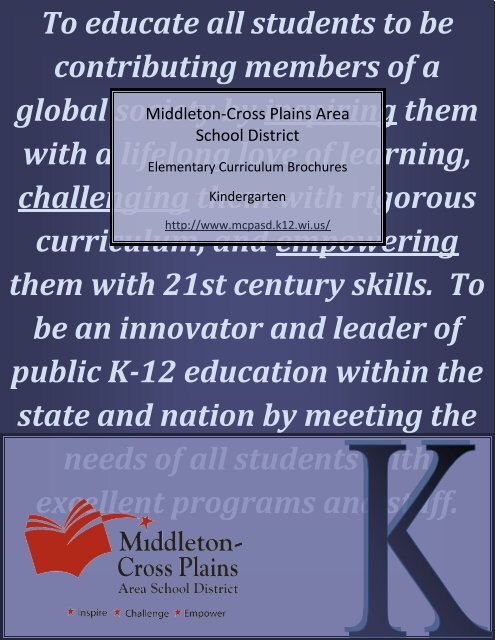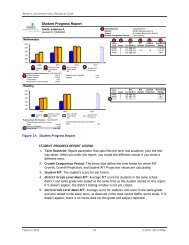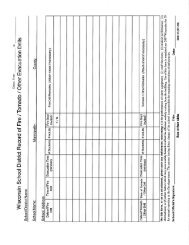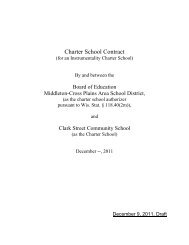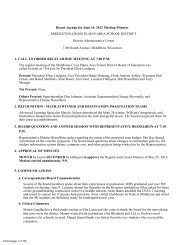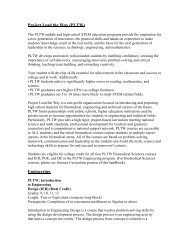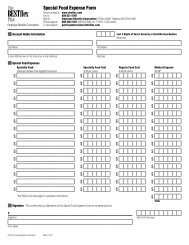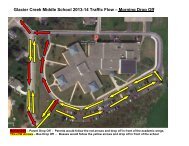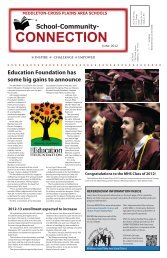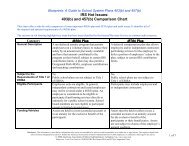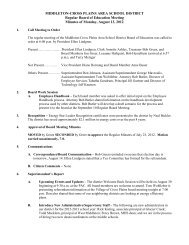Kindergarten curriculum guide - Middleton Cross Plains Area School ...
Kindergarten curriculum guide - Middleton Cross Plains Area School ...
Kindergarten curriculum guide - Middleton Cross Plains Area School ...
You also want an ePaper? Increase the reach of your titles
YUMPU automatically turns print PDFs into web optimized ePapers that Google loves.
To educate all students to be<br />
contributing members of a<br />
global society <strong>Middleton</strong>-<strong>Cross</strong> by inspiring <strong>Plains</strong> <strong>Area</strong> them<br />
<strong>School</strong> District<br />
with a lifelong love of learning,<br />
Elementary Curriculum Brochures<br />
challenging them<br />
<strong>Kindergarten</strong><br />
with rigorous<br />
http://www.mcpasd.k12.wi.us/<br />
<strong>curriculum</strong>, and empowering<br />
them with 21st century skills. To<br />
be an innovator and leader of<br />
public K-12 education within the<br />
state and nation by meeting the<br />
needs of all students with<br />
excellent programs and staff.
Literacy<br />
Students in grades<br />
kindergarten through<br />
second have a literacy block with a minimum of 90<br />
minutes daily. This provides a focused time to<br />
develop skills in reading, writing and word study.<br />
MCPASD teachers use whole group instruction,<br />
small group instruction, individual instruction and<br />
independent practice to differentiate for the<br />
student learner.<br />
All students are actively engaged in learning<br />
whether they are in a small teacher led group of<br />
students or reading independently, or writing.<br />
Independent activities will often focus on concepts<br />
being studied in science, and social studies.<br />
Reading<br />
The National Reading Panel identified key skills and<br />
methods central to reading achievement. The five<br />
essential elements of reading instruction are what<br />
we teach. The elements are phonemic awareness,<br />
phonics, vocabulary,<br />
fluency, and<br />
comprehension. Current<br />
research states that<br />
systematic and explicit<br />
approaches to instruction in<br />
each of the major<br />
components are<br />
imperative.<br />
Balanced Literacy<br />
Balanced literacy is how we teach literacy. It<br />
involves several methods for teaching reading and<br />
writing. These essential literacy skills are taught in<br />
the context of authentic reading and writing<br />
experiences. There are eight components of<br />
balanced literacy: reading aloud, shared reading,<br />
<strong>guide</strong>d reading, independent reading, modeled &<br />
shared writing, <strong>guide</strong>d writing, independent<br />
writing, and interactive writing.<br />
The power of the balanced literacy framework is<br />
the manner in which students are supported as<br />
they are exposed to new learning and <strong>guide</strong>d as<br />
P a g e | 2<br />
they learn to use skills and strategies<br />
independently. During read alouds and modeled<br />
writing lessons, the teacher explicitly models<br />
his/her own thinking for students. Students are<br />
supported as they learn to apply new skills and<br />
strategies in authentic reading and writing tasks.<br />
Our ultimate goal is for students to take on the<br />
responsibility for these skills and strategies and be<br />
able to use them independently.<br />
Writing Process<br />
We use Units of Study for<br />
Primary Writing, developed by<br />
Lucy Calkins and her colleagues<br />
from the Teachers College<br />
Reading and Writing Project.<br />
Each year, teachers deliver<br />
seven “units of study,” each lasting four to six<br />
weeks.<br />
<br />
<br />
<br />
<br />
<br />
<br />
Launching the Writing Workshop<br />
Small Moments: Personal Narrative Writing<br />
The Craft of Revision<br />
Authors as Mentors<br />
Nonfiction Writing: Procedures and Reports<br />
Poetry: Powerful Thoughts in Tiny Packages<br />
6 + 1 Traits<br />
Not only do we talk about the writing process, we<br />
also talk about the craft of writing. We use the<br />
common language of the 6 + 1 Traits of Writing to<br />
discuss and describe authors’ craft. The 6 + 1 traits<br />
include the following: ideas, organization, voice,<br />
word choice, sentence fluency, conventions, and<br />
presentation.<br />
Handwriting Without Tears<br />
Handwriting Without Tears is a<br />
research based developmentally<br />
appropriate program. It is the<br />
selected manuscript handwriting<br />
program because it is an easy-toteach,<br />
easy-to-learn <strong>curriculum</strong> that<br />
makes handwriting mastery joyful<br />
for students and their teachers.<br />
MCPASD <strong>Kindergarten</strong> Curriculum Brochure
Mathematics<br />
Children’s experiences shape their attitude toward<br />
mathematics. The Everyday Mathematics<br />
<strong>curriculum</strong> is engaging,<br />
encouraging, and designed to build<br />
children’s understanding over time.<br />
This program respects children’s<br />
intuitive understanding of<br />
mathematics and helps them<br />
develop the range of sophisticated mathematical<br />
knowledge and skills necessary for success in our<br />
information and technology oriented world.<br />
In Everyday Mathematics, all students in grades K-5<br />
develop a broad background by learning concepts<br />
and skills in the six content strands of Number and<br />
Numeration; Operations and Computation; Data<br />
and Chance; Measurement and Reference Frames;<br />
Geometry; and Patterns, Functions, and Algebra.<br />
The <strong>Kindergarten</strong> program emphasizes the<br />
following content.<br />
Number and Numeration<br />
<br />
<br />
<br />
<br />
<br />
P a g e | 3<br />
Counting orally forward and backward<br />
beyond 10<br />
Counting objects with oneto-one<br />
correspondence<br />
Exploring concepts of<br />
quantity, “more,” and<br />
“less” using concrete<br />
materials<br />
Beginning to recognize numerals<br />
Understanding the uses of numbers<br />
Operations and Computation<br />
<br />
<br />
Exploring addition and subtraction concepts<br />
Using fingers, manipulatives, or other<br />
strategies to solve number stories<br />
Data and Chance<br />
<br />
<br />
Working together to collect and visually<br />
represent meaningful data<br />
Answering questions and learning<br />
information from data displays<br />
Measurement and Reference Frames<br />
<br />
<br />
<br />
<br />
<br />
Making direct comparisons of length,<br />
weight, and capacity<br />
Using language to describe the sizes of<br />
objects and size comparisons<br />
Beginning to explore<br />
measurement using<br />
nonstandard units<br />
Experimenting with<br />
standard measuring<br />
tools<br />
Sequencing familiar events in time<br />
Geometry<br />
<br />
<br />
Exploring 2- and 3-dimensional shapes<br />
Developing an understanding of position<br />
and spatial relations concepts<br />
Patterns, Functions, and Algebra<br />
<br />
<br />
<br />
Identifying, describing and extending sound,<br />
movement, and visual patterns<br />
Identifying,<br />
comparing, and<br />
describing attributes<br />
of objects<br />
Sorting objects by<br />
attributes<br />
In Everyday Mathematics you can<br />
expect to see…<br />
<br />
<br />
<br />
<br />
<br />
A problem-solving approach based on<br />
everyday situations<br />
Key mathematical ideas repeated over time<br />
in slightly different ways<br />
Learning through age-appropriate, playful<br />
activities<br />
A broad range of mathematics topics based<br />
on an optimistic view of children’s<br />
capabilities and motivation to learn<br />
Opportunities to “do math” at home<br />
MCPASD <strong>Kindergarten</strong> Curriculum Brochure
Science<br />
<br />
<br />
<br />
<br />
<br />
<br />
The <strong>Middleton</strong>-<strong>Cross</strong> <strong>Plains</strong><br />
<strong>Area</strong> <strong>School</strong> District utilizes<br />
the Full Option Science<br />
System (FOSS) at the K-5<br />
Level. FOSS strives to<br />
develop students' abilities<br />
to do and understand<br />
scientific inquiry through:<br />
Asking and answering questions<br />
Planning and conducting simple<br />
investigations<br />
Employing tools and techniques to gather<br />
data<br />
Using data to construct reasonable<br />
explanations<br />
Communicating investigations and<br />
explanations<br />
Understanding that scientists use different<br />
kinds of investigations and tools to develop<br />
explanations using evidence and knowledge<br />
In <strong>Kindergarten</strong> the students are exposed to one of<br />
two content kits within the strands of Physical<br />
Science and Life Science.<br />
Life Science<br />
The Animals Two by Two Module provides young<br />
students with close and personal interaction with<br />
some common land and water animals.<br />
Appropriate classroom<br />
habitats are established,<br />
and students learn to care<br />
for the animals. In four<br />
activities the animals are<br />
studied in pairs. Students<br />
observe and care for one<br />
animal over time, and then<br />
they are introduced to another animal similar to<br />
the first but with differences in structure and<br />
behavior. This process enhances opportunities for<br />
observation, communication, and comparison.<br />
In the Trees Module,<br />
systematic investigation of<br />
trees will bring students to<br />
a better understanding of<br />
trees' place at school and<br />
in the community, and will<br />
provide some solid<br />
experiences on the way to<br />
understanding all plants.<br />
Physical Science<br />
In the Wood and Paper Module<br />
students are introduced to a wide<br />
variety of woods and papers in a<br />
systematic way. They will observe the<br />
properties of these materials and<br />
discover what happens when they are<br />
subjected to a number of tests and<br />
interactions with other materials.<br />
Students learn that wood and paper<br />
can be recycled to create new forms of paper or<br />
wood that have new properties. Finally, they use<br />
what they know about the properties of these<br />
marvelous materials as they change wood and<br />
paper into a variety of products. Throughout the<br />
module, students have ample opportunities to<br />
compare different kinds of wood, different types of<br />
paper, and wood and paper. The concept of trees<br />
as natural resources is introduced.<br />
Fabric, a material so<br />
often taken for<br />
granted, makes a<br />
fascinating study for<br />
early-childhood<br />
students. In the<br />
Fabric Module<br />
students are introduced to a wide variety of fabrics<br />
in a systematic way, so that they become familiar<br />
with fabrics' properties, discover what happens<br />
when they are tested, and discover how they<br />
interact with other materials, including water.<br />
P a g e | 4<br />
MCPASD <strong>Kindergarten</strong> Curriculum Brochure
Social Studies<br />
The elementary social studies<br />
<strong>curriculum</strong> is based on the 2010<br />
National Council for the Social<br />
Studies standards. The aim of<br />
social studies is the promotion of<br />
civic competence. Young people<br />
who are knowledgeable, skillful, and committed to<br />
democracy are necessary to sustaining and<br />
improving our democratic way of life, and<br />
participating as members of a global society. The<br />
national standards are focused on ten themes.<br />
These themes represent a way of categorizing<br />
knowledge about the human experience, and they<br />
constitute the organizing strands that thread<br />
through our elementary social studies program.<br />
Culture<br />
Time, Continuity, and Change<br />
People, Places, and Environments<br />
Individual Development and Identity<br />
Individuals, Groups, and Institutions<br />
Power, Authority, and Governance<br />
Production, Distribution, and Consumption<br />
Science, Technology, and Society<br />
Global Connections<br />
Civic Ideals and Practices<br />
At the elementary level, these themes are explored<br />
through an age-appropriate “lens.” In<br />
kindergarten, the scope of the social studies<br />
<strong>curriculum</strong> is “Me, My Family, and Others.”<br />
Teachers and students use the TCI Social Studies<br />
Alive! Me and My World materials. Units of study<br />
include the following:<br />
Who Am I?<br />
<br />
<br />
<br />
<br />
<br />
<br />
What is a Family?<br />
How Do I Get Along With Others?<br />
How Do I Make Friends and Solve Problems<br />
With Others?<br />
How Can I Be a Good Helper and Help Take<br />
Care of My Classroom?<br />
What Is the Difference Between a Personal<br />
Want and a Need?<br />
How Do We Use Technology in the Home<br />
and Classroom?<br />
Visual Arts<br />
Art is a way of understanding ourselves and our<br />
relationship with the world around us. Throughout<br />
the K-12 Art program, students explore the three<br />
essential questions of:<br />
<br />
<br />
<br />
What is art?<br />
How is art created?<br />
Why is art important?<br />
Students explore the answers to the above<br />
questions when engaged in art experiences<br />
focused around the following six Art standards.<br />
Creation<br />
Understanding and applying media, techniques,<br />
and processes<br />
Perception<br />
Using knowledge of structures and functions<br />
Interpretation<br />
Choosing and evaluating a range of subject matter,<br />
symbols, and ideas<br />
Relation<br />
Understanding the visual arts in relation to history<br />
and cultures<br />
Reflection<br />
Reflecting upon and assessing the characteristics<br />
and merits of their work and the work of others<br />
Connection<br />
Making connections between visual arts and other<br />
disciplines<br />
P a g e | 5<br />
MCPASD <strong>Kindergarten</strong> Curriculum Brochure
Music<br />
What Exactly Do We Do In Music Class?<br />
The short answer to this<br />
question is that in music class<br />
we sing, play instruments, and<br />
learn about how music works.<br />
But there's more to it than that<br />
- music in the <strong>Middleton</strong>-<strong>Cross</strong><br />
<strong>Plains</strong> <strong>Area</strong> <strong>School</strong> District reflects the national<br />
music education standards, also adopted in the<br />
state of Wisconsin. Our Elementary Music<br />
Curriculum is based on students learning eight<br />
main concepts:<br />
Time: beat, rhythm, meter, rhythmic notation,<br />
playing rhythmic patterns on instruments, time<br />
signatures, improvising rhythms<br />
Pitch: matching pitch, relationship of pitches to<br />
each other,<br />
Melody: types of melodic movement, playing<br />
and singing melodies, improvising/composing<br />
melodies<br />
Harmony: performing accompaniments,<br />
learning to sing and play rounds, melodies with an<br />
ostinato, echo harmony, partner songs, countermelodies,<br />
simple harmonic theory<br />
Form: recognizing sounds that are the same or<br />
different; form (structure of songs/compositions),<br />
solo vs. group, types of form: AB, ABA, rondo,<br />
sonata, suite<br />
Expression: tempo,<br />
texture, dynamics, phrasing,<br />
and articulation<br />
Timbre: effects and mood,<br />
instrument families, world<br />
instruments, ensembles, and orchestra<br />
History and Culture: relationship of music to<br />
society, function of music, multicultural music,<br />
music of famous composers, music of American<br />
composers, musical styles<br />
P a g e | 6<br />
These eight concepts are geared towards students<br />
increasing in skill level in each of the eight areas.<br />
The <strong>curriculum</strong> model designed to increase skill<br />
level throughout all conceptual areas as students<br />
get older is also known as a spiral<br />
<strong>curriculum</strong>. Over the course of the elementary<br />
music experience, the use of each concept<br />
becomes more sophisticated. For example, in<br />
regard to time, students learn about and practice<br />
keeping steady beat in kindergarten, but by 5 th<br />
grade are working on eight and sixteenth notes, as<br />
well as triplets and the offbeat.<br />
Technology<br />
As foundational technology skills<br />
penetrate throughout our<br />
society, students will be expected<br />
to apply the basics in authentic,<br />
integrated ways to solve<br />
problems, complete projects, and<br />
creatively extend their abilities. Students at the<br />
elementary level participate in technology<br />
enrichment classes, and students in grades 4 and 5<br />
participate in keyboarding classes. The technology<br />
standards and <strong>curriculum</strong> help students prepare to<br />
work, live, and contribute to the social and civic<br />
fabric of their communities.<br />
Technology standards<br />
addressed at the elementary<br />
level identify several higherorder<br />
thinking skills and<br />
digital citizenship as critical<br />
for students to learn effectively for a lifetime and<br />
live productively in our emerging global society.<br />
These areas include the ability to:<br />
<br />
<br />
<br />
<br />
<br />
Demonstrate creativity and innovation<br />
Communicate and collaborate<br />
Conduct research and use information<br />
Think critically, solve problems, and make<br />
decisions<br />
Use technology effectively and productively<br />
MCPASD <strong>Kindergarten</strong> Curriculum Brochure
Physical<br />
Education<br />
Physical activity is critical to the<br />
development and maintenance<br />
of good health. The goal of<br />
physical education is to develop<br />
physically educated individuals<br />
who have the knowledge, skills and confidence to<br />
enjoy a lifetime of healthful physical activity. A<br />
physically educated person:<br />
Standard 1:<br />
Demonstrates competency in motor skills and<br />
movement patterns needed to perform a variety of<br />
physical activities.<br />
Standard 2:<br />
Demonstrates understanding of movement<br />
concepts, principles, strategies, and tactics as they<br />
apply to the learning and performance of physical<br />
activities.<br />
Standard 3:<br />
Participates regularly in physical activity.<br />
Standard 4:<br />
Achieves and maintains a health-enhancing level of<br />
physical<br />
fitness.<br />
Standard 5:<br />
Exhibits<br />
responsible<br />
personal and<br />
social behavior<br />
that respects<br />
self and others in physical activity settings<br />
Standard 6:<br />
Values physical activity for health, enjoyment,<br />
challenge, self-expression, and/or social interaction<br />
Ideas and Resources for Parents<br />
Go on a number or shape hunt.<br />
Have your child practice counting forward<br />
or backward.<br />
Play a card or board game.<br />
http://www.fossweb.com/<br />
http://www.pta.org/K_B-W.pdf<br />
P a g e | 7<br />
MCPASD <strong>Kindergarten</strong> Curriculum Brochure


